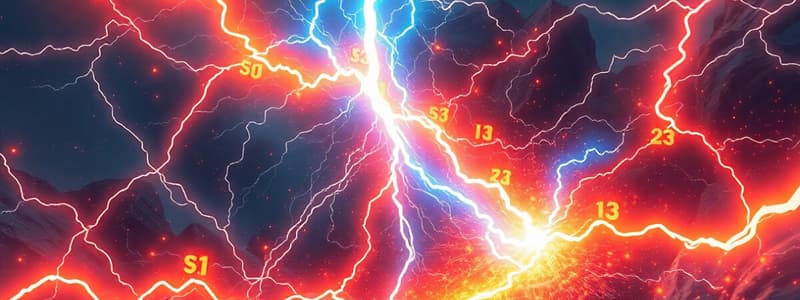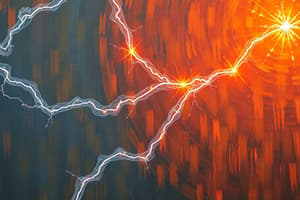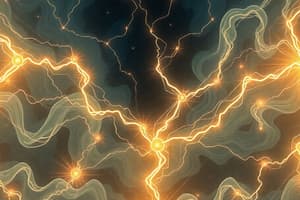Podcast
Questions and Answers
What is the fundamental unit of electric charge?
What is the fundamental unit of electric charge?
- Coulomb (C) (correct)
- Watt (W)
- Volt (V)
- Ampere (A)
Direct current (DC) changes direction sinusoidally with time.
Direct current (DC) changes direction sinusoidally with time.
False (B)
Define voltage in terms of energy and charge.
Define voltage in terms of energy and charge.
Voltage is the energy required to move a unit charge through an element.
Power is the time rate of expending or absorbing ________, measured in watts (W).
Power is the time rate of expending or absorbing ________, measured in watts (W).
Match the following circuit elements with their descriptions:
Match the following circuit elements with their descriptions:
What is the value of 'e', the charge on one electron?
What is the value of 'e', the charge on one electron?
The charges that occur in nature can be non-integral multiples of the electronic charge.
The charges that occur in nature can be non-integral multiples of the electronic charge.
Express the mathematical relationship between current, charge, and time.
Express the mathematical relationship between current, charge, and time.
The unit of ampere can be derived as 1 A = 1 ______/s.
The unit of ampere can be derived as 1 A = 1 ______/s.
Match the descriptions with the correct inequality regarding voltage $V_{ab}$:
Match the descriptions with the correct inequality regarding voltage $V_{ab}$:
In the passive sign convention, what is the expression for power when it is being absorbed?
In the passive sign convention, what is the expression for power when it is being absorbed?
According to the law of conservation of energy, the sum of power in a circuit is always equal to one.
According to the law of conservation of energy, the sum of power in a circuit is always equal to one.
What does the integral $\int_{t_0}^{t} pdt$ represent?
What does the integral $\int_{t_0}^{t} pdt$ represent?
A ________ source is an active element in which the source quantity is controlled by another voltage or current.
A ________ source is an active element in which the source quantity is controlled by another voltage or current.
Match the following source types with their characteristics:
Match the following source types with their characteristics:
What are the four different types of dependent sources?
What are the four different types of dependent sources?
Based on Ohm's Law, what is the formula for voltage (V)?
Based on Ohm's Law, what is the formula for voltage (V)?
Conductance is the same as the value of resistance
Conductance is the same as the value of resistance
What is the total voltage (v) given, $v_x = 15$ (V) where current $i_2 = 1A$ with an additional voltage source of 10 V
What is the total voltage (v) given, $v_x = 15$ (V) where current $i_2 = 1A$ with an additional voltage source of 10 V
Given that $V_{ab}$ equals zero, this is called _______ circuit.
Given that $V_{ab}$ equals zero, this is called _______ circuit.
Flashcards
What is electric charge?
What is electric charge?
Electrical property of atomic particles; measured in coulombs (C).
What is electric current?
What is electric current?
Electric current is the time rate of change of charge, measured in amperes (A); 1 A = 1 C/s.
What is voltage?
What is voltage?
The energy required to move a unit charge through an element; measured in volts (V).
What is power?
What is power?
Signup and view all the flashcards
Active vs. Passive elements?
Active vs. Passive elements?
Signup and view all the flashcards
What is a dependent source?
What is a dependent source?
Signup and view all the flashcards
What is Ohm's Law?
What is Ohm's Law?
Signup and view all the flashcards
What is a Resistor?
What is a Resistor?
Signup and view all the flashcards
Study Notes
- Chapter 1 discusses basic electrical engineering concepts, including:
- Electric charge
- Current
- Voltage
- Power and energy
- Circuit elements
Electric Charge
- Charge is an electrical property of atomic particles.
- It is measured in coulombs (C).
- The charge (e) of one electron is negative and equals 1.602 x 10^-19 C in magnitude.
- This charge is called electronic charge.
- Charges that occur in nature are integral multiples of the electronic charge.
Current
- Electric current (i) is expressed as i = dq/dt, where the unit of ampere is derived as 1 A = 1C/s.
- Direct current (dc) remains constant over time.
- Alternating current (ac) varies sinusoidally with time and reverses direction.
Voltage
- Voltage (or potential difference) is the energy needed to move a unit charge through an element, measured in volts (V).
- Mathematically, voltage (Vab) = dw/dq, where w is energy in joules (J) and q is charge in coulombs (C).
- Electric voltage (Vab) exists across a circuit element or between two points in a circuit.
- If Vab > 0, the potential at point 'a' is higher than at point 'b'.
- If Vab < 0, the potential at point 'a' is lower than at point 'b'.
Power and Energy
- Power is the time rate of expending or absorbing energy.
- It is measured in watts (W).
- Mathematically, p = dw/dt = (dw/dq) * (dq/dt) = vi.
- Passive sign convention dictates:
- p = +vi implies absorbing power
- p = -vi implies supplying power.
- The law of conservation of energy states that the sum of power in a circuit is zero (∑p = 0).
- Energy measures the capacity to do work and is measured in joules (J).
- Mathematically, w = integral of pdt from t0 to t = integral of vidt from t0 to t.
Circuit Elements
- Circuit elements are categorized into active and passive elements.
- A dependent source is an active element which is controlled by another voltage or current.
- Dependent sources include:
- VCVS (Voltage-Controlled Voltage Source)
- CCVS (Current-Controlled Voltage Source)
- VCCS (Voltage-Controlled Current Source)
- CCCS (Current-Controlled Current Source).
- Voltage, v, in a circuit with a current-independent 10V source and a current-dependent voltage source vx can be calculated as v = 10 + vx.
- If vx = 15i2 as shown in the example where i2 = 1A, then v = 10 + 15(1) = 25 V.
- Note the factor of 15 has the units of resistance, or ohms (Ω).
Studying That Suits You
Use AI to generate personalized quizzes and flashcards to suit your learning preferences.




